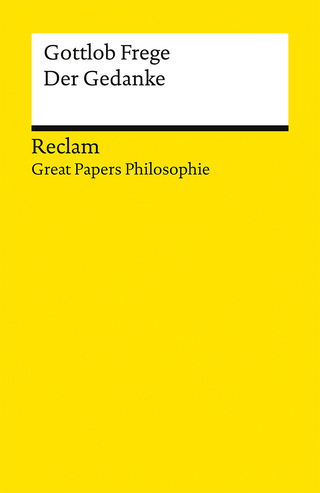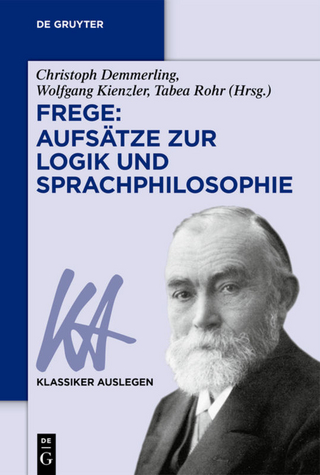
How to Think Logically
Pearson (Verlag)
978-0-205-15498-2 (ISBN)
- Titel z.Zt. nicht lieferbar
- Versandkostenfrei innerhalb Deutschlands
- Auch auf Rechnung
- Verfügbarkeit in der Filiale vor Ort prüfen
- Artikel merken
Packages
Access codes for Pearson's MyLab & Mastering products may not be included when purchasing or renting from companies other than Pearson; check with the seller before completing your purchase.
Used or rental books
If you rent or purchase a used book with an access code, the access code may have been redeemed previously and you may have to purchase a new access code.
Access codes
Access codes that are purchased from sellers other than Pearson carry a higher risk of being either the wrong ISBN or a previously redeemed code. Check with the seller prior to purchase.
-- Concise Principles of Reasoning
Concise, yet covering all the basics of a 15-week course in informal logic or critical reasoning, this text engages students with a lively format and clear writing style. The small scale of the book keeps the cost low, a vital consideration in today’s economy, yet without compromising on logical rigor.
The author’s presentation strikes a careful balance: it offers clear, jargon-free writing while preserving rigor. Brimming with numerous pedagogical features, this accessible text assists students with analysis, reconstruction, and evaluation of arguments and helps them become independent, analytical thinkers. Introductory students are exposed to the basic principles of reasoning while also having their appetites whetted for future courses in philosophy.
Teaching and Learning Experience
Improve Critical Thinking - Abundant pedagogical aids -- including exercises and study questions within each chapter -- encourage students to examine their assumptions, discern hidden values, evaluate evidence, assess their conclusions, and more!
Engage Students - Chapter and section outlines, summaries, illustrative examples, special-emphasis boxes and key terms present new ideas in manageable-sized units of information so students can digest each concept before moving on to the next one, and ensure students key-in on crucial points to remember.
Support Instructors -Teaching your course just got easier! You can create a Customized Text or use our Instructor’s Manual, or PowerPoint Presentation Slides. Plus, this concise textbook contains only as much material as you can cover in a course, creating an affordable alternative you can assign with confidence to a cost-conscious student population. Additionally, each chapter in How to Think Logically is designed as a self-contained unit so that you can choose the combination and order of chapters according to the needs of your courses; making the text a flexible base for courses in logic, critical thinking, and rhetoric.
In This Section: I. Author Bio II. Author Letter I. Author Bio Gary Seay has taught formal and informal logic since 1979 at the City University of New York, where he is presently professor of philosophy at Medgar Evers College. His articles on moral philosophy and bioethics have appeared in The American Philosophical Quarterly, The Journal of Value Inquiry, The Journal of Medicine and Philosophy, and The Cambridge Quarterly of Healthcare Ethics, among other journals. With Susana Nuccetelli, he is editor of Themes from G. E. Moore: New Essays in Epistemology and Ethics (Oxford University Press, 2007), Philosophy of Language: The Central Topics (Rowman & Littlefield, 2007), and Latin American Philosophy: An Introduction With Readings (Prentice Hall, 2004). Gary Seay may be contacted at garys@mec.cuny.edu. For more information about his work, visit http://www.mec.cuny.edu/academic_affairs/libarts_ed_school/phil_rel_dept/seay_bio.asp. Susana Nuccetelli is professor of philosophy at St. Cloud State University in Minnesota. Her essays in epistemology and philosophy of language have appeared in Analysis, The American Philosophical Quarterly, Metaphilosophy, The Philosophical Forum, Inquiry, and The Southern Journal of Philosophy, among other journals. She is editor of New Essays in Semantic Externalism and Self-Knowledge (MIT Press, 2003) and author of Latin American Thought: Philosophical Problems and Arguments (Westview Press, 2002). She is co-editor of The Blackwell Companion to Latin American Philosophy (Blackwell, 2009) and, with Gary Seay, Ethical Naturalism: Current Debates (Cambridge University Press, forthcoming, 2011). Susana Nuccetelli may be contacted at snuccetelli@stcloudstate.edu. For more information about her work, visit http://web.stcloudstate.edu/sinuccetelli/. II. Author Letter Dear Colleague, Now in a new Second Edition, How to Think Logically is a concise and user-friendly textbook for freshman-level logic and critical thinking courses. Focused throughout on arguments and how we may evaluate them, the book is intended to show students how to distinguish between arguments that ought to persuade us and those that should not. It presents students with criteria for assessing both deductive and inductive reasoning, and it does so in a clear writing style much praised by our students. "This book is well written and structured," students have told us again and again over the ten semesters since it first appeared. "It’s easy to understand." We believe that critical thinking skills are more vital than ever as a component of a liberal education. In a world where college graduates face increasingly fierce competition for jobs, those who are careful reasoners, lucid writers, and clear-headed thinkers are simply better equipped to succeed in any area of specialization. Learning these skills, however, should not be a dry, dull process, but an exercise leavened with humor and down-to-earth examples that students can understand. How to Think Logically accomplishes these goals with materials designed specifically for readers who have never encountered philosophy before, and for whom analytical thinking may at first be an unfamiliar exercise. In our courses at the City University of New York, at St. Cloud State University in Minnesota, and at the University of Texas Pan American, we have used this book with students from a great number of different nationalities, ethnicities, and economic backgrounds. Invariably, we find that students respond well to its simple format, lively examples, and plain language. In addition, this textbook comprises only enough material for a standard fifteen-week course (with flexibility to allow instructors options for different approaches); thus students are not paying for material they don’t use. This helps us keep costs down, a welcome feature at a time when students are struggling with soaring tuition and fees! But at no point does How to Think Logically compromise on logical rigor. The book charts a mainstream course through discussions of natural language, meaning, truth, belief, and definition. It discusses twenty of the most common informal fallacies, explaining what is wrong with each type and how to avoid it. It also includes an expanded treatment of deductive reasoning, both in modern, propositional logic (including the rudiments of symbolic notation and natural deduction) and traditional, syllogistic logic. We believe that this is the book instructors have been looking for. It presents a broad and immensely readable approach to introductory-level logic, yet it does so concisely and at moderate cost. We are interested in hearing from instructors who adopt our book, since we do value their suggestions for improving it. We want to know what works best in the classroom. So please do email us if you have suggestions or criticisms at garys@mec.cuny.edu and sinuccetelli@stcloudstate.edu. We look forward to learning about your experiences with How to Think Logically. Sincerely, Gary Seay and Susana Nuccetelli City University of New York and St. Cloud State University
IN THIS SECTION:
1.) BRIEF
2.) COMPREHENSIVE
BRIEF TABLE OF CONTENTS
PART I: THE BUILDING BLOCKS OF REASONING
Chapter One What Is Logical Thinking? And Why Should We Care?
Chapter Two Thinking Logically and Speaking One’s Mind
Chapter Three The Virtues of Belief
PART II: REASON AND ARGUMENT
Chapter Four Tips for Argument Analysis
Chapter Five Evaluating Deductive Arguments
Chapter Six Analyzing Inductive Arguments
PART III: INFORMAL FALLACIES
Chapter Seven Some Ways an Argument Can Fail
Chapter Eight Avoiding Ungrounded Assumptions
Chapter Nine From Unclear Language to Unclear Reasoning
Chapter Ten Avoiding Irrelevant Premises
PART IV: MORE ON DEDUCTIVE REASONING
Chapter Eleven Compound Propositions
Chapter Twelve Checking the Validity of Propositional Arguments
Chapter Thirteen Categorical Propositions and Immediate Inferences
Chapter Fourteen Categorical Syllogisms
Appendix: Summary of Informal Fallacies
Answers to Selected Exercises
Glossary/Index
COMPREHENSIVE TABLE OF CONTENTS
PART I: THE BUILDING BLOCKS OF REASONING
Chapter One What Is Logical Thinking? And Why Should We Care?
1.1 The Study of Reasoning
1.2 Logic and Reasoning
1.3 What Arguments Are
1.4 Reconstructing Arguments
1.5 Arguments and Non-arguments
1.6 Chapter Summary
1.7 Key Words
Chapter Two Thinking Logically and Speaking One’s Mind
2.1 Rational Acceptability
2.2 Beyond Rational Acceptability
2.3 From Mind to Language
2.4 Indirect Use and Figurative Language
2.5 Definition: An Antidote to Unclear Language
2.6 Chapter Summary
2.7 Key Words
Chapter Three The Virtues of Belief
3.1 Belief, Disbelief, and Non-Belief
3.2 Beliefs’ Virtues and Vices
3.3 Accuracy and Truth
3.4 Reasonableness
3.5 Consistency
3.6 Conservatism and Revisability
3.7 Rationality vs. Irrationality
3.8 Chapter Summary
3.9 Key Words
PART II: REASON AND ARGUMENT
Chapter Four Tips for Argument Analysis
4.1 A Principled Way of Reconstructing Arguments
4.2 Missing Premises
4.3 Extended Arguments
4.4 Types of Reason
4.5 Norms and Argument
4.6 Chapter Summary
4.7 Key Words
Chapter Five Evaluating Deductive Arguments
5.1 Validity
5.2 Soundness
5.3 Cogency
5.4 Chapter Summary
5.5 Key Words
Chapter Six Analyzing Inductive Arguments
6.1 Reconstructing Inductive Arguments
6.2 Some Types of Inductive Argument
6.3 Evaluating Inductive Arguments
6.4 Chapter Summary
6.5 Key Words
PART III: INFORMAL FALLACIES
Chapter Seven Some Ways an Argument Can Fail
7.1 What Is a Fallacy?
7.2 Classification of Informal Fallacies
7.3 When Inductive Arguments Go Wrong
7.4 Chapter Summary
7.5 Key Words
Chapter Eight Avoiding Ungrounded Assumptions
8.1 Fallacies of Presumption
8.2 Begging the Question
8.3 Begging-the-Question-Against
8.4 Complex Question
8.5 False Alternatives
8.6 Accident
8.7 Chapter Summary
8.8 Key Words
Chapter Nine From Unclear Language to Unclear Reasoning
9.1 Unclear Language and Argument Failure
9.2 Semantic Unclarity
9.3 Vagueness
9.4 Ambiguity
9.5 Confused Predication
9.6 Chapter Summary
9.7 Key Words
Chapter Ten Avoiding Irrelevant Premises
10.1 Fallacies of Relevance
10.2 Appeal to Pity
10.3 Appeal to Force
10.4 Appeal to Emotion
10.5 Ad Hominem
10.6 Beside the Point
10.7 Straw Man
10.8 Is the Appeal to Emotion Always Fallacious?
10.9 Chapter Summary
10.10 Key Words
PART IV: MORE ON DEDUCTIVE REASONING
Chapter Eleven Compound Propositions
11.1 Argument as a Relation Between Propositions
11.2 Simple and Compound Propositions
11.3 Symbolizing Compound Propositions
11.4 Defining Connectives with Truth Tables
11.5 Truth Tables for Compound Propositions
11.6 Chapter Summary
11.7 Key Words
Chapter Twelve Checking the Validity of Propositional Arguments
12.1 Checking Validity with Truth Tables
12.2 Some Standard Argument Forms
12.3 Formal Fallacies
12.4 A Simplified Approach to Proofs of Validity
12.5 Chapter Summary
12.6 Key Words
Chapter Thirteen Categorical Propositions and Immediate Inferences
13.1 What Is a Categorical Proposition?
13.2 Venn Diagrams for Categorical Propositions
13.3 The Square of Opposition
13.4 Other Immediate Inferences
13.5 Chapter Summary
13.6 Key Words
Chapter Fourteen Categorical Syllogisms
14.1 What Is a Categorical Syllogism?
14.2 Syllogistic Argument Forms
14.3 Testing for Validity with Venn Diagrams
14.4 Distribution of Terms
14.5 Rules of Validity and Syllogistic Fallacies
14.6 Chapter Summary
14.7 Key Words
Appendix: Summary of Informal Fallacies
Answers to Selected Exercises
Glossary/Index
| Erscheint lt. Verlag | 2.3.2012 |
|---|---|
| Sprache | englisch |
| Maße | 177 x 231 mm |
| Gewicht | 520 g |
| Themenwelt | Geisteswissenschaften ► Philosophie ► Logik |
| ISBN-10 | 0-205-15498-0 / 0205154980 |
| ISBN-13 | 978-0-205-15498-2 / 9780205154982 |
| Zustand | Neuware |
| Haben Sie eine Frage zum Produkt? |
aus dem Bereich


